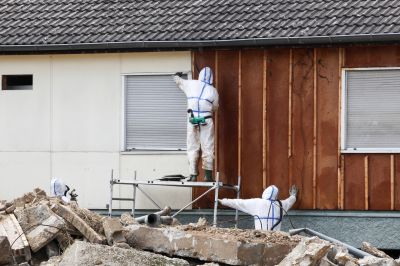Leading Products For Asbestos Service Professionals
Explore essential tools and equipment designed to ensure safety, efficiency, and compliance in asbestos removal and management.
 Handling asbestos requires specialized tools and protective equipment to ensure safety during inspection, removal, or remediation processes. Professionals often utilize a variety of products designed to detect, contain, and safely dispose of asbestos-containing materials. These products are essential for minimizing health risks associated with asbestos fibers, which can become airborne if disturbed improperly. Proper selection and use of these tools can significantly improve safety protocols and compliance with safety regulations.
Handling asbestos requires specialized tools and protective equipment to ensure safety during inspection, removal, or remediation processes. Professionals often utilize a variety of products designed to detect, contain, and safely dispose of asbestos-containing materials. These products are essential for minimizing health risks associated with asbestos fibers, which can become airborne if disturbed improperly. Proper selection and use of these tools can significantly improve safety protocols and compliance with safety regulations.
Top Overall Option
Comprehensive Asbestos Inspection and Safety Kit
This all-in-one kit provides a variety of detection tools, PPE, and containment supplies suitable for professional asbestos inspection and removal projects. It includes handheld testers, protective gear, and containment materials designed to facilitate safe and thorough work processes.
Types of Products For Asbestos Service
Asbestos Detection Test Kits
Portable kits that allow quick preliminary assessment of suspect materials to identify potential asbestos presence.
Moisture Meters
Devices used to measure moisture levels in building materials, aiding in identifying areas prone to asbestos disturbance.
Negative Air Machines
Air filtration units that create negative pressure environments to contain asbestos fibers during removal.
Plastic Sheeting and Drop Cloths
Heavy-duty plastic materials used to seal off work areas and prevent fiber spread.
Personal Protective Equipment (PPE)
Includes respirators, coveralls, gloves, and eye protection designed to safeguard workers from asbestos exposure.
Asbestos Disposal Bags
Specialized, labeled bags for secure containment and transportation of asbestos waste.
Sealing and Encapsulation Products
Materials used to seal or encapsulate asbestos-containing materials to prevent fiber release.
Vacuum Systems with HEPA Filters
High-efficiency vacuum cleaners designed for asbestos cleanup and debris removal.
Air Quality Monitors
Real-time devices that measure airborne asbestos fibers during and after removal procedures.
Work Gloves and Coveralls
Protective clothing designed to prevent fiber transfer and skin contact during asbestos handling.
Asbestos Sampling Kits
Tools and containers for collecting samples for laboratory analysis.
Containment Barriers and Tents
Portable structures or barriers used to isolate work zones and contain fibers.
Decontamination Units
Facilities or equipment used to thoroughly decontaminate personnel and tools after asbestos work.
Communication Devices
Two-way radios and signaling equipment to coordinate safety efforts on-site.
Signage and Warning Labels
Clear markers to alert personnel and the public about asbestos-related hazards.
Popular Choices
Widely used for quick screening of suspected materials before professional assessment.
Commonly utilized for cleaning work areas contaminated with asbestos fibers.
Essential PPE for workers to prevent inhalation of asbestos fibers during removal or inspection.
Popular for creating sealed work zones to contain asbestos fibers effectively.
Frequent choice for protective clothing that can be discarded after use.
Commonly used to prevent fiber transfer during handling and removal.
Often employed for real-time assessment of airborne asbestos during work activities.
Portable structures that help isolate work areas during asbestos removal.
Standard for safely packaging asbestos waste for transportation and disposal.
Popular for thorough cleaning of personnel after asbestos work.
Trusted for detailed cleanup of asbestos-contaminated surfaces.
Widely used to alert others of asbestos hazard zones.
Commonly used for collecting material samples for laboratory testing.
Frequently employed to restrict access to asbestos work areas.
Popular for sealing plastic sheeting and barriers securely.
Often selected for on-site personnel decontamination procedures.
Asbestos service products include detection devices such as handheld testers and moisture meters, which help identify suspect materials. Containment solutions like negative air machines and plastic sheeting are used to isolate affected areas and prevent fiber dispersal. Personal protective equipment (PPE) such as respirators, coveralls, and gloves are critical for worker safety. Additionally, specialized disposal bags and sealing kits facilitate the secure removal and transportation of asbestos waste.
Choosing the right products depends on the scope of the project, the type of asbestos materials involved, and safety standards. For example, professionals conducting inspections might prioritize sensitive detection devices, while removal teams focus on containment and protective gear. Quality and reliability are key considerations to ensure that equipment performs as expected under challenging conditions. Proper training combined with appropriate tools can help mitigate health hazards and ensure compliance with legal requirements.
Key Buying Considerations
- Ensure products meet safety standards and certifications relevant to asbestos handling.
- Select detection tools with high sensitivity for accurate identification of asbestos materials.
- Prioritize PPE that provides reliable respiratory and skin protection during work activities.
- Consider ease of use and portability of detection and containment equipment.
- Evaluate the compatibility of containment supplies with the size and layout of the work area.
- Look for durable materials that withstand repeated use or disposal requirements.
- Assess the level of filtration efficiency in vacuum systems and air purifiers.
- Verify that disposal bags and sealing products are appropriately labeled and compliant with regulations.
- Determine if sampling kits are compatible with laboratory testing requirements.
- Choose products that facilitate efficient workflow and compliance documentation.
- Review product reviews and safety data sheets to ensure reliability and safety.
- Consider the scope of your project to determine if a comprehensive kit or individual items are more suitable.
- Check for compatibility with existing safety protocols and procedures.
- Factor in storage and transportation needs for larger or bulkier equipment.
- Ensure that training or instructions are available for proper product use and safety.
This page contains affiliate links. We may earn a commission from qualifying purchases to support our content and ongoing research.
